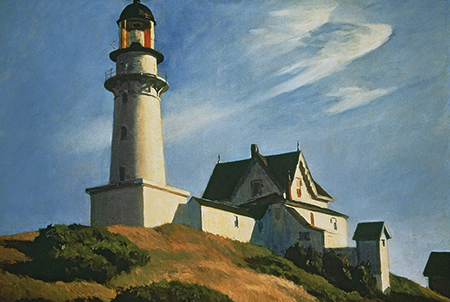
Having originally taught English literature in a university night-school setting for a decade in the 1980s, I later realized that, during the day, I was becoming an art critic, concentrating on transitioning from reviewing books to reviewing art exhibitions at the behest and encouragement of both artists and magazine editors. Eventually, the downtown satellite campus closed and my role as "adjunct instructor" ended. Meanwhile my activities as an art critic increased. However, I have retained a strong interest in fiction and now, having known so many artists, there are a pair of novels I believe artists and fans of art would enjoy reading. They are short, they are clearly written, and each is peripherally or directly about being an artist and art-lover. One is comic and the other is in-between, as Virginia Woolf's books are frequently categorized.
"To the Lighthouse" (1927) by Woolf (1882-1941) is one of the greatest novels of the past century — and one of the shortest. Although the main character, Mrs. Ramsay, dies half-way through the book, the other main character, Lily Briscoe, is a painter who remains haunted by the older woman's beauty, hospitality, and wisdom. Lily is working on a summer landscape while a guest at the Ramsays' beach house on the Isle of Skye in Scotland. Other guests include a couple who get engaged while there, an aging poet (and former opium addict who becomes a great success later in life) and a Cambridge protégé of old Mr. Ramsay's, the distinguished scholar, grumpy husband and father of five children (like Virginia Woolf's father).
So far, the plot sounds much like the family and friends in Woolf's own life (her mother died when she was 13) and Woolf admitted that, in writing the book, she was able to purge her grief for her mother once and for all. Filled with beautiful descriptions and thoughtful interior monologues by various characters, the story is driven by a plan to row out to the nearby lighthouse. Much of the book is filled with hesitations, plans, revisions and finally the trek over water to the vaguely symbolic destination. Lily Briscoe is painting the whole scene (as Woolf is writing the whole book) and, when they arrive, Lily sees the landing party and realizes her painting is done, too. It's one of the most radiant conclusions to a novel ever written, summing up the artist's challenges and satisfactions: "With a sudden intensity, as if she saw it clear for a second, she drew a line there, in the center. It was done; it was finished. Yes, she thought, laying down her brush in extreme fatigue, I have had my vision."
Completely different in tone, "Love Junkie" (1992) by Robert Plunkett (who is now a real estate agent and gossip columnist in Sarasota, FL) chronicles the rise and fall and rise of Mrs. Boyce Smithers of Bronxville, NY, a socialite who's just ruined a reception in honor of Mrs. John D. Rockefeller III and then heads to Greenwich Village for a respite from boring suburbia. She wants to get more involved in contemporary art. The running gag is that the gay porn studio she discovers is, she is told, an avant-garde non-profit art space, like so many such real spaces in New York at that time. It is difficult to write comic novels that do not date (Evelyn Waugh was perhaps the most reknowned success) because so much humor is timely. But imagine a comic novel in which the other protagonist dies of AIDS and the heroine becomes an heiress who cheerfully then funds and produces "quality" gay porn films.
Part Candide, part Isabel Archer, Mimi Smithers is a great comic heroine, so dim at times that she cannot tell that her beloved is a gay porn star, Tom Potts, or that her other handsome new friend, Joel, uses her to finance the porn films he writes and directs at the nonprofit. Innocent up to a point, Mimi typifies the so-called "Bridge and Tunnel" crowd of the 1980s, eager to be cool, but nervous at times and mostly clueless. She's taken for a ride by the gay characters who are maliciously and hilariously condescending to Mimi as they clean her clock — and bank accounts. The book initially received mixed reviews: too sarcastic, too grim considering the circumstances. But 26 years later it enjoys an ardent cult following. No, you don't have to be gay to enjoy it, but remembering New York in the 1980s, if you were there, will be a big boost to appreciating much of the humor between the lines, while following poor Mimi's (as in "La Bohème"?) divagations across Manhattan.
